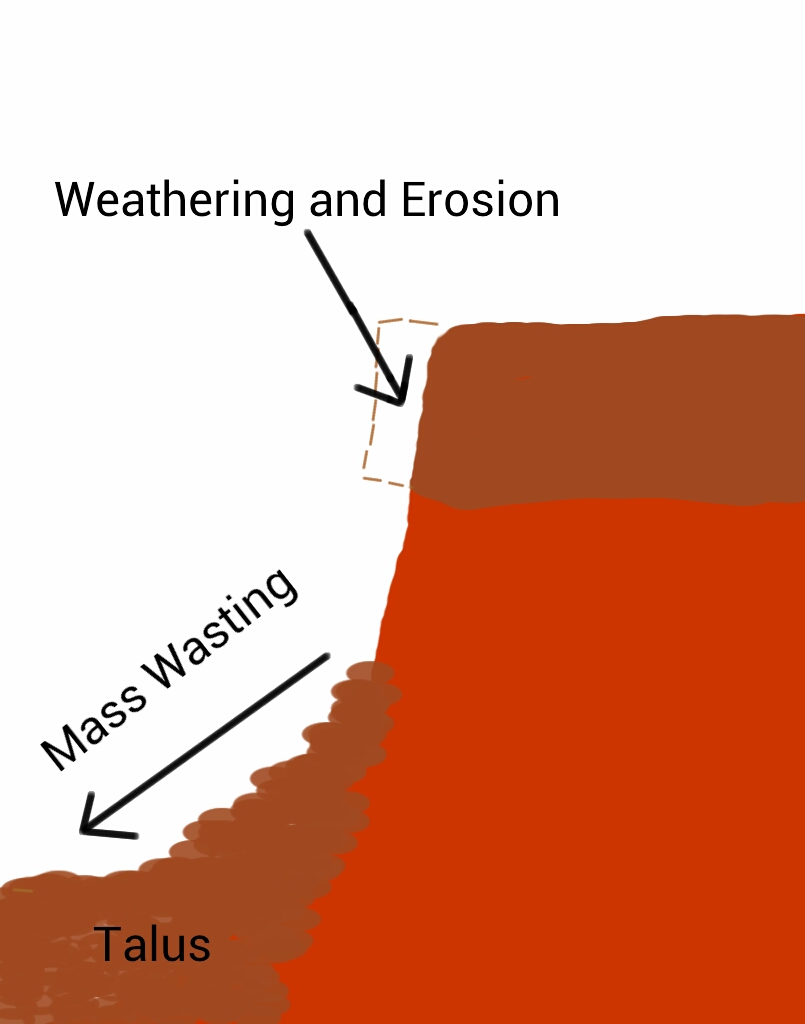Driving along US-285, rocks of all sizes litter the bases of the foothills of the Sangre de Cristo Mountains. These are talus slopes. They hold an important geology lesson of weathering and erosion. You can view and learn about these formations and earn a smiley without stopping your car.
Talus deposits are common formations adjacent to cliff faces. The deposits are made when rock fragments (scree) from an adjacent cliff accumulate at the base of the cliff through periodic rockfall. The size of the scree in the talus deposits can range from grains of sand to large boulders.
Relative and Absolute Age Dating of Scree in Talus Deposits
The relative age of talus compared to the surrounding rocks can be found by using geologic context. For example, scree in talus deposits are derived from an adjacent cliff, so the scree must be the same age of the cliff the scree came from. Then, using the geologic principle of Superposition, we know the rock underlying the talus must be older than the talus deposit.
In the case of the talus deposits along US-285, the talus deposits are of Jurassic origin or in some cases Cretaceous. The talus deposits are of the same age as the top cliff layer of the hill. The rocks underlying the talus deposits are of Triassic or Permian age.
Talus Rock Sizes
There are four main rock sizes in talus deposits*:
- Sand is the smallest grain of rock found in talus deposits.
Diameter<~1mm
- Soil is larger than sand but still relatively small.
~1mm to ~10mm
- Regolith can be relatively large fragments of rock or small rock like sand and soil. Sand or soil can be classified as regolith and sand or soil.
~1mm to ~1/2m
- Large Rocks are the largest material found in talus deposits. They usually consist of boulder sized fragments. As long as the boulder is not loose, it is not considered regolith.
Diameter>~1/2m
*Note that the diameter of each rock size is approximate and may vary
Weathering, Erosion, and Mass Wasting - The Formation of Talus
Rocks or scree in talus deposits are derived from the adjacent cliff. Over time, the cliff is weathered and eroded away to form talus deposits. The process of scree moving down the slope is called mass wasting.
In the cooler months, the cliff is weathered away when rainwater seeps into pores and cracks of the exposed rocks of the cliff. The rainwater freezes expanding its volume by nine percent and turning into ice. Since the volume of the rainwater is now greater than when the rainwater was liquid, the pores and cracks are expanded by the growing ice. The expansion of the pores and cracks of the exposed rock allows more rainwater to seep in. Eventually, the expanding ice will shatter the exposed rock, adding scree to the pile of talus.
In the warmer months, rainwater slowly erodes the exposed rocks by seeping into the rock's pores and cracks. The cracks and pores are gradually eroded until the exposed rock breaks into fragments, adding scree to the pile of talus.

Geologic Terms
Mass Wasting- the process of scree moving down a slope by creep, rockfall, or rockslide
Scree- the rock fragments that compose talus deposits
Talus Deposit/Slope- the resulted formation of scree at the base of a cliff
Principle of Superposition- a geologic principle which states that a layer of sedimentary rock in a tectonically undisturbed sequence is older than the rock above it and younger than the rock below it
Logging Requirement:
Prior to logging your find, email me the answers to the following logging requirements via geocaching.com. Use the reading and your observations at the site to answer the logging requirements. Title the email "Tell Us About Talus - GC4W4MP - Logging Requirement". All finds without the required email may be deleted without notice.
- Estimate the diameter of a rock in the talus deposit. What talus rock size would it be classified as? It may be classified in two groups.
- What is the name of the process that forms talus deposits?
- Are the talus deposits older or younger than the rock underlying them?
Remember to use CITO and Leave No Trace techniques. Happy caching!
I have earned GSA's highest level:
